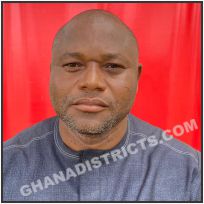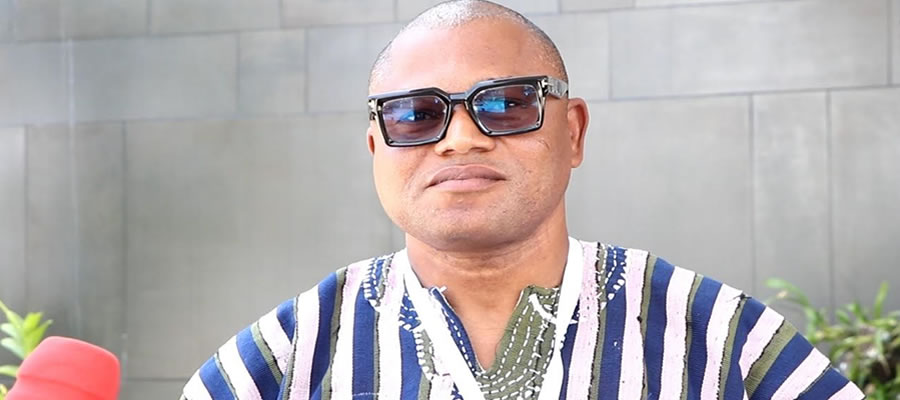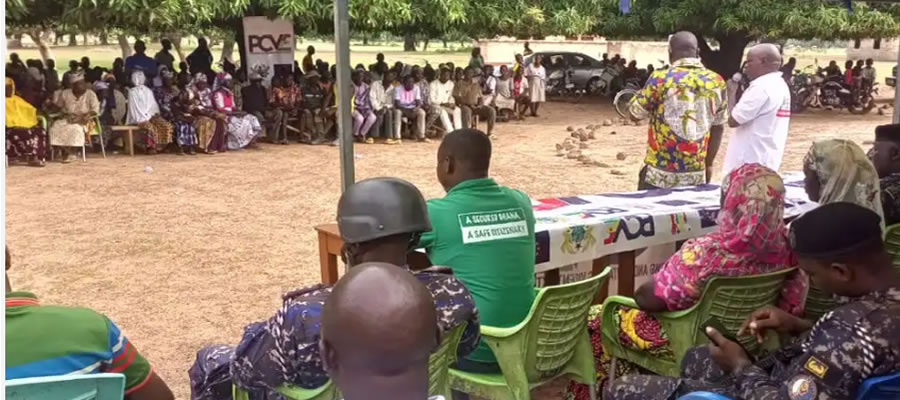

EMPLOYMENT SECTOR AND PRODUCTIVITY
Skilled agricultural forestry and fishery workers are the dominant occupation in the district recording 85.2 percent. The majority (84.4%) of males find themselves within the skilled agricultural forestry and fishery compared to 82.8% of females engaged in the same sector. This leading occupational category does not require skilled expertise and high educational training.
The major outputs of farmers are maize, millet, groundnuts, onions, watermelon, and livestock such as pigs, cattles, sheep and goats. Poultry, especially guinea fowl production, is quite significant. The long dry season coupled with the inadequate number of irrigable dams compel the youth of the District to migrate to the southern sector of the country during the lean season in search of menial jobs.
Only few proportion of employed persons (2.2%) engage in the occupations which require high skills and several years of training such as managers, professionals and technicians and associate professionals. The proportion of males in the various occupations was higher than females, the only exceptions being service and sales workers. Both sexes recorded the same proportion of managers.
The long dry season coupled with the inadequate number of irrigable dams compel the youth of the District to migrate to the southern sector of the country during the lean season in search of menial jobs. Other areas that offer employment to the people are craft and related trades workers (5.8%), service and sales workers (5.1%), Professionals (1.4%) and 2.5 percent engage are absorbed by other areas.
Garu, the District capital has the potential of becoming a vibrant commercial centre, which should stimulate and spur growth in the other areas.
The District is relatively stable, without conflict. The major challenge confronting the district is the need to consolidate the peace and harmony that have existed through building trust and confidence among the ethnic and social groups in the District. This was threatened by the December 2007 communal violence in Bawku and the 2012 general elections.
Specific economic activities include onion cultivation and marketing in the dry season, water melon production and marketing, cattle and other livestock trading, smock weaving and production, pottery, and metal forging and fabrication.
Given the fact that about 85.2% of the District’s population is engaged in agriculture and the evidence provided in the Ghana Living Standards Survey, 2000, that the majority of the poor in Ghana are food crop producers, is ample testimony of the level of poverty in the District.
The private informal sector is the largest employer in the district constituting 97 percent. This could be the result of the relatively low levels of educational and professional training among the employed population, since these sectors do not require high levels of formal education.
The proportion of employed females as shown in Table 4.6, working in the private informal sector is 98.2 percent whiles that of males is 95.5 percent. Among the workforce, 0.9 percent is employed in the private formal sector. The public sector, covering Government Ministries, Departments and Agencies, employs 1.8 percent of the total employed population. The proportion of males and females employed in the public sector are 3.1 percent and 0.8 percent respectively.
DISTRICT REVENUE AND EXPENDITURE PATTERN
This section gives an analysis of the District administration capacity in generating revenue to finance development projects. It also looks at the expenditure pattern of the District in relation to its revenue generation through a time service analysis. It finally examines the existing revenue collection system of the District and its problems.
SOURCES OF REVENUE
Revenue to the District is generated from both internal and external sources. The internally generated revenue comes from sources such as rent, land, fees/fines, licenses and investments. On the other hand, the DACF and donor funds constitute the main source of external revenue. Table below shows the various sources of internally and externally generated revenues and their contributions to the District total revenue from 2010 – 2013.
It can be observed from the above table that the District’s total revenue saw an average percentage increase of about 94.63% between 2010 and 2013 due majorly to the enrolment of more schools into the Ghana Schools’ Feeding Programme in 2012 and 2013, the expansion of GSOP budget. On the other hand, it is explicit that the District is highly dependent on external sources of revenue which accounts for 97.07% of the total revenue realized by the District within 2010 to 2013 medium term period. Of recent, the District receives huge sums of money from the District Development Facility Fund (DDF) as a result of its incredible performance in the Functional Organisational Assessment Tool (FOAT).
Though internally generated revenue shows an increasing trend from 2010 to 2012, its contribution of 3.7% to total revenue realized in 2012 indicate the abysmal performance of internal revenue generation. The situation worsen in 2013 when IGF dropped by 25.69% from the 2012 amount and contributed only 1.64% to total revenue realized in 2013. The contribution of IGF to total revenue had dropped continuously over the years. In the 2010-2013 District Medium Term period, IGF only contributed 2.77% total revenue received for the period.
The above trend has serious implications for the District’s development drive. This is because development projects are likely to grind to a halt in the case of delays in the release of funds from external sources. Thus, there is the ardent need for the District to strengthen its revenue collection unit and also invest into ventures that have the potential of high revenue turnover.
REVENUE MOBILIZATION
Revenue mobilization in the District is done through the use of commission collectors, revenue tax forces and Unit Committees. As observed earlier the District depends heavily on external sources of revenue to finance most of its development projects. This problem is traceable to a plethora of problems facing the revenue collection unit of the District. Problems such as the lack of logistics for revenue collectors, inadequate civic awareness on tax obligation, public abuse and humiliation of tax collectors, tax evasion, inadequate tax collectors and limited number of revenue sources have contributed in no small measure to the abysmal local revenue mobilization of the District.
This further brings to light the need for the capacity of the revenue collection unit of the District to be strengthened in terms of logistics and personnel to enable it to perform its avowed functions effectively.
EXPENDITURE
The main areas of expenditure of the District can be conveniently grouped into capital and recurrent. The capital expenditure of the District includes all social and economic investments while the recurrent expenditure entails expenditure made for the smooth running of the District administration. The table below shows the expenditure pattern of the District from 2010 to 2013.
Recurrent expenditure saw an increase between 2010 and 2012 from 10% to 16.6% except for 2011 where there was a decline in terms of its contribution to total expenditure thus 2.8%. There has however been consistency of expenditure on local governance which is aimed at strengthening the local governance structures in communities to enhance their active involvement in decision making.
REVENUE- EXPENDITURE MATCHING
The revenue expenditure matching of the District has been analysed to ascertain whether the District Assembly has the capacity of generating revenue to finance development projects. This is also to give information about the surplus made or the deficits incurred by the District. The table below shows the revenue and expenditure matching and their associated deficit/surplus from 2010 – 2012 for the District.
From the table above, the District recorded income surpluses in 2010 but had deficits in 2011 and 2012. Following the trend of deficits as show in the table above, it is most likely that the district would record another deficit at the close of the year. This situation indicates the importance of the DACF in the District Assembly spending. The untimely release of this fund therefore will be major setback in the implementation of projects. Nevertheless, this situation does not paint a good picture in terms of the Districts capacity in mobilizing internal revenue for development.
REVENUE AND EXPENDITURE FOR THE PERIOD 2010 TO 2013
The table below matches revenue and expenditure items of the district from 2010 to 2012. It can be observed that in most of the items listed in the table, the district records d eficits. There is therefore the need for stakeholders to record the spending track in order not to spend beyond the revenue received for the year.
Investment Opportunities
Investment opportunities/ economic resources consist of:
- Agriculture with vast potentials in cashew, onion, water melon, Soya bean, mango, groundnuts etc.
- Small scale industries including
- Motor /bicycle repairs
- Carpentry and masonry
- Weaving and dress making
- Leather and textile
- Black smiting
- Pottery
- Basket weaving
- Local soap manufacture
- Agro processing:
- Shea butter extraction
- Dawadawa processing
- Pito brewing
- Groundnut oil extraction
- Rice par boiling
- Few tourist attractions are the slave market at Senebaga and the Woriyanga mosque. There are some guest houses, beer bars and restaurants.
- There is two Banks in the District, the BESSFA Rural Bank and First National Bank, and 2 credit unions which are engaged in savings mobilisations and provision of credit facilities to both private and public operators.
- There is one FM station in the District (Quality FM).
- Communication consists of a few radio phones and several mobile phones. Most of the radio phones are not in operation.
A visit to the district capital and other communities show the existence of most of some telecommunication companies such as Vodafone, MTN, Tigo, Zain and Glo. Apart from facilitating communication, their presence also provides employment to a few individuals.
Economic facilities consists of:
- 14 Markets of which only Garu market have modern stores and stalls. The markets apart from Garu market are Woriyanga, Worikambo, Basyonde, Bugri, Denugu and Songo. Others are Tariganga, Sinorgo, Dabila, Benwoko, Konkomada, Avosum Markets, and Kongo.
- Roads-Mainly Feeder Roads. The total engineered roads =277.1km, the total unengineered roads =122.9
- Dams: there are few dams and dugouts in the District. Some of them are Bugri Dam, Basyonde Dam, Kongo Dam, Tempane Dam, Songo Dam, Woriyanga dam, Denugu dam, Worikambo dam and Zonmadiga dam etc.
- 5 Guest Houses namely, Quality Lodge, Symbolic Guest House, Presby Guest House, Catholic ITC Guest House and CBR guest House all in Garu
- Lorry Parks: there are lorry parks in all the markets but none is developed etc.
The District has the potential to grow if all the necessary human and material resources are well harnessed. This could be done in an environment of transparent private public sector collaboration such as private public participation (PPP).
Prioritisation Of Development Issues
THEMATIC AREAS
This Chapter shows the District Development priorities adopted from the NMTDF 2014-2017 under the 7 Thematic Areas such as:
- Ensuring and sustaining macroeconomic stability;
- Enhanced Competitiveness of Ghana’s Private Sector;
- Accelerated Agricultural Modernisation and Natural Resource Management;
- Oil and Gas Development;
- Infrastructure and Human Settlements Development;
- Human development, Employment and Productivity; and
- Transparent and Accountable Governance.
ANALYSIS OF SOCIAL AMENITIES IN COMMUNITIES
Information from 96 communities in the District reveals the social amenities gabs in the District. Many of the communities did not have some of the basic social and economic infrastructure. The graph below shows the communities that have and those who did not have the amenities.
Date Created : 11/20/2017 6:42:08 AM











 facebook
facebook
 twitter
twitter
 Youtube
Youtube
 +233 593 831 280
+233 593 831 280 0800 430 430
0800 430 430 GPS: GE-231-4383
GPS: GE-231-4383 info@ghanadistricts.com
info@ghanadistricts.com Box GP1044, Accra, Ghana
Box GP1044, Accra, Ghana